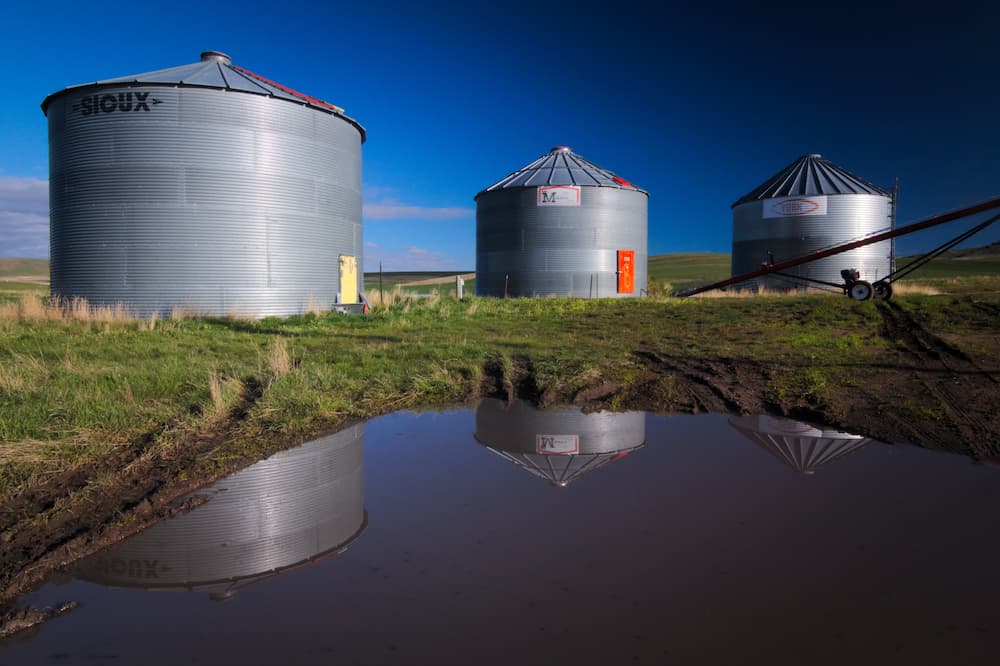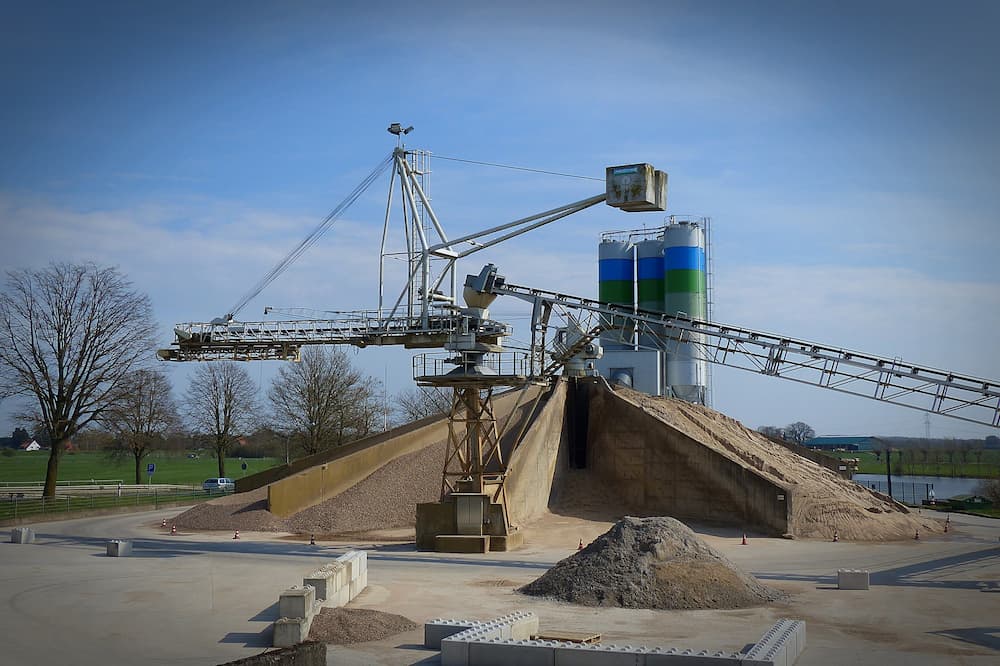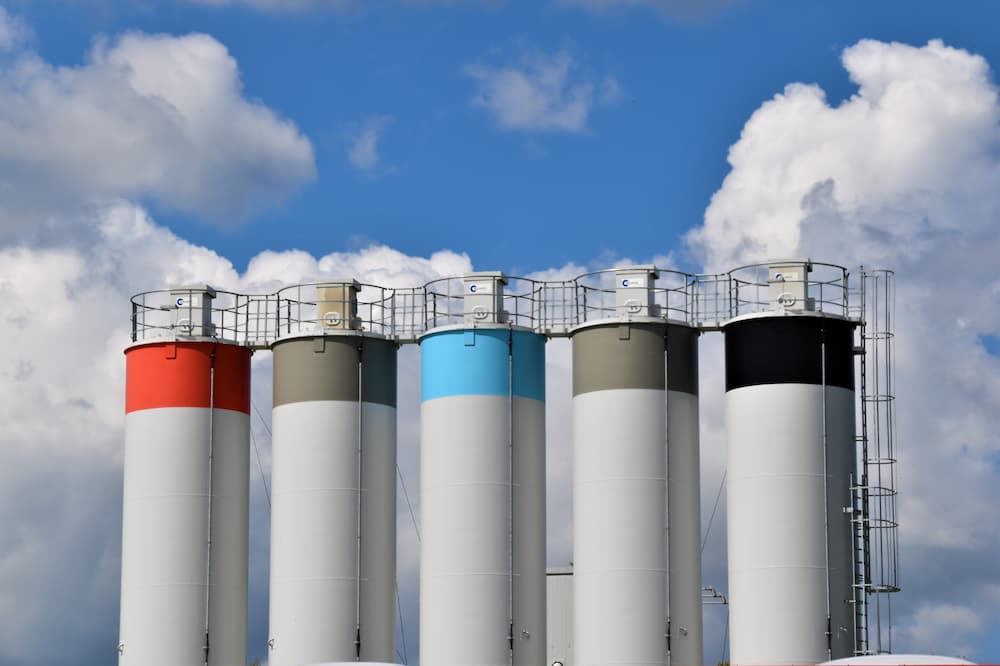Calculations for Silo Design and Hoppers
There’s more to silo operations than just putting material into a bin and removing it - calculations are necessary if you want a successful operation with minimal mistakes.
The discharge process is often overlooked, but this is one of the most detrimental parts of the whole operation. Things such as arching and ratholing can occur, so steps need to be taken in the design of the silo and feeders to prevent such events.
Keep reading to find out more about silos, and what needs to be considered when designing a silo.
What Is A Silo?
A silo is a large bin or tower that’s used to store bulk materials. Some materials commonly stored in silos include sand, cement, grains, and metals - but pretty much any bulk material can be stored in a silo.
Typically, silos are made using large sheets of steel for durability and strength. These sheets are often ribbed on the inside to ensure that material doesn’t stick on the silo wall, which reduces product loss.
Silos can vary in height to accommodate the amount of bulk material and the surrounding environment, but they tend to range from 10m to 90m tall, accommodating weights of up to 80 tons.
The removal of the material depends on your supplier and what the material actually is - however, silos usually have an access point on the roof to put the product in, and an exit point on the bottom for removal.
Some ways of removing the material include the power of gravity, an auger, or a pneumatic conveying system.
A typical silo features a cone-shaped design, which helps you gain control of the bulk material flow. If pneumatic conveyors are in place to remove the bulk materials, then a conveyor tube is attached to the bottom of the silo, to ensure no product is wasted and that the process is more streamlined.
In larger workplaces where a large number of materials are being stored and processed, multiple silos will be connected to the same conveying system to save time, manpower, and money.
Other silos are placed on a raised platform so a removal truck can park directly underneath and collect the load. This is a cost-effective method, but generally, you’ll find that multiple trips will need to be made to collect all of the bulk material from the silo.
Mass Flow
Flow issues can be prevented by making sure that mass flow occurs inside the silo or hopper (depending on the material). To achieve mass flow, you must make sure that the walls are steep enough, and the friction levels are low enough for the bulk materials to slide down.
To achieve this, you must make sure that the materials are tested and that the walls are measured - and then you must calculate the right hopper angle to allow mass flow to occur.
Mass flow bins are ideal if you want a reliable and steady flow out of the silo. However, mistakes can be made, and what you think is a mass flow bin can actually be a funnel flow bin, causing problems with the flow.
To overcome this, you will want to recalculate the angle of discharge and the minimum diameters - reassessing every calculation made to determine the silo or hopper measurements.
In a hopper or a silo, there are two main flow patterns that can occur.
Bulk Flow
In bulk flow, all of the solids are moving when the material is being emptied from the outlet, which stops material from getting stuck to the walls of the silo. This encourages the materials to flow in a ‘“first in first out” manner, providing a more structured exit, preventing ratholing and sifting segregation.
FIFO (first in first out) is more effective with bulk flow. Mass flow bins can be sensitive to arching, so this is something to watch out for during the process.
Funnel Flow
Bulk flow and funnel flow are very different flow methods. Funnel flow tends to be more chaotic and is more likely to worsen the segregation of materials. Funnel flow can also result in stagnant material being left inside (ratholes) the edges of the silo or hopper. Ratholing can lead to particle degradation, caking, and spoilage, which is not only a waste of product but a waste of time and space.
With a funnel flow, the product leaves the silo in the centre of the bin, creating a funnel shape. This can cause both arching and ratholing - we’ll go into more detail on arching and ratholing soon.
Calculation Methods
Powders can be difficult to control when stored in a silo or hopper and can slide and fall. When a large amount of powder is stored in a bin, it’s submitted to pressure due to the height of the powder and the weight of the powder on top pushing down on the powder below. This can have an impact on flowability.
Because of this pressure, solids tend to be cohesive. When this occurs, arching and ratholes can occur, which can be detrimental to the flow of the powder when discharging from the silo or hopper.
Arching and Ratholing
Arching and ratholing relate to the flowability of bulk solids and powders. Arching occurs when a powder is stored in a hopper that doesn’t have steep enough cone walls or a large enough outlet.
For improved flowability, powders need to be submitted to a constraint. The constraint depends on the outlet shape, and whether the powder can support it to consolidate itself and create arches. If the angle of the exit isn’t steep enough, then it’s likely that an arch will form.
Calculating the hopper wall angle is and the critical outlet diameter is critical in preventing arches from forming and if you want the powder to flow.
Ratholing can be avoided if you pay attention to calculations. The hopper must be designed so the outlet diameter is larger than the outlet rathole critical diameter. The rathole diameter is usually larger than the arching diameter.
This effect only tends to happen with powders, and the effect can be very different when liquids are stored.
The flow of powder in a silo/ hopper is determined by 3 things - the internal friction of the powder, how easily the powder can move on the surface of the silo walls, and how the powder compacts under the weight of the top-level powder.
How you measure these properties is important - if you want high flowability, you must follow the steps below.
Learn About The Powder
Knowing all about the powder and its properties is key if you want the powder to flow. You must learn the powder flow function, the static angle of internal friction, and the wall friction angle.
It’s important to know the characteristics of the product to discharge - and these can be determined by a shear tester. Once you learn these characteristics, you can calculate the critical discharge diameter. This is the diameter that the product will risk to arch - and different diameters can be calculated depending on the bin used.
Find Out The Angle For Mass Flow
Mass flow is imperative if you want a clean, rathole-free flow. The first step is deciding whether you need a conical hopper shape or a wedge hopped shape - but this depends on the environment and the material being stored.
In the food industry, conical hoppers are more desirable as they’re easier to clean - but in many other instances, wedge-shaped hoppers are used as they’re generally bigger. You’ll also have to determine the type of power feeder at the base and factor this into your operation. For example, star valves are far more difficult to fit in a wedge-shaped hopper, so this is something that should be considered.
Feeders
A feeder can help to control the flow of the materials exiting the hopper or silo. Feeders are also useful as they can dose the solid, and reach another unit while lowering the installation height.
The feeder should always be sized correctly - if the feeder is too small, the powder can flow poorly and chaotically and can result in a funnel flow bin instead of a mass flow bin.
A poorly fitted or constructed feeder can be the source of many other issues in the process - flow being the main one. You should be especially careful with hoppers that have slotted outlets, as the feeder needs to draw perfectly along the entire cross-section of the outlet. Although hoppers with slotted outlets carry more risk, hoppers with round outlets can still have uneven flow if the hopper interface isn’t designed and fitted with exact precision.
The design of the feeder is extremely important - it must be designed to bring the material out of the entire silo or hopper bin. A good feeder design will have large and steel pipe slopes to ensure the material flows quickly and efficiently, and will also be able to take the powder in the whole section of the outlet.
Three main feeders are used in most cases in the industry, and they are:
Butterfly Valves
Butterfly valves are the simplest types of valve positioned on the outlet of a silo. As opposed to other types of valves, butterfly valves are super hygienic - but they do have a disadvantage.
Once open, materials can be left in the passing area - and sometimes there can be enough material to form a new bridge. For very cohesive powders, you may need discharging aids and even vibrating valves to overcome this.
Screw Feeders
Although screw feeders are effective, it’s important to note that if the powder exits from this type of feeder unevenly, then structural damage may occur on large silos. If the screw feeder is placed below an elongated hopper, be sure to use a pitch to keep on taking powder in the flow direction. If you don’t the screw feeder will fill up pretty quickly and will only be taken out on one side.
Rotary Valves
Rotary valve feeders need to make sure that there’s a 2 diameter section of pipe between the hopper and the valve. This is to regulate and improve the flow and to hopefully result in a better mass flow.
This type of feeder is typically placed under hoppers that have round outlets. When you use a rotary valve, you must make sure that a short vertical spool is installed between the hopper outlet and the valve inlet to make sure that the flow pattern is correct.
Discharge Rate
Calculating the discharge rate is imperative if you want to improve your system. There are two widely used equations to determine this - the Johanson equation and the Berverloo equation.
Although these two equations can help you to estimate the flow, it’s important to note that they offer no certain accurate figure.
The Berverloo equation is direct, but for finer particles, you may get an overestimated discharge rate.
Although many people are skilled in liquids and gases, not many people know the ins and outs of bulk material handling. Knowing how a hopper or silo design can have an effect on a materials cohesive strength is imperative for a successful operation, and know knowing this can result in costly mistakes.



